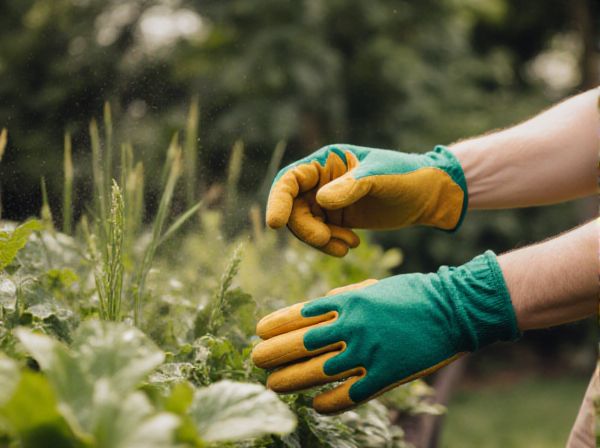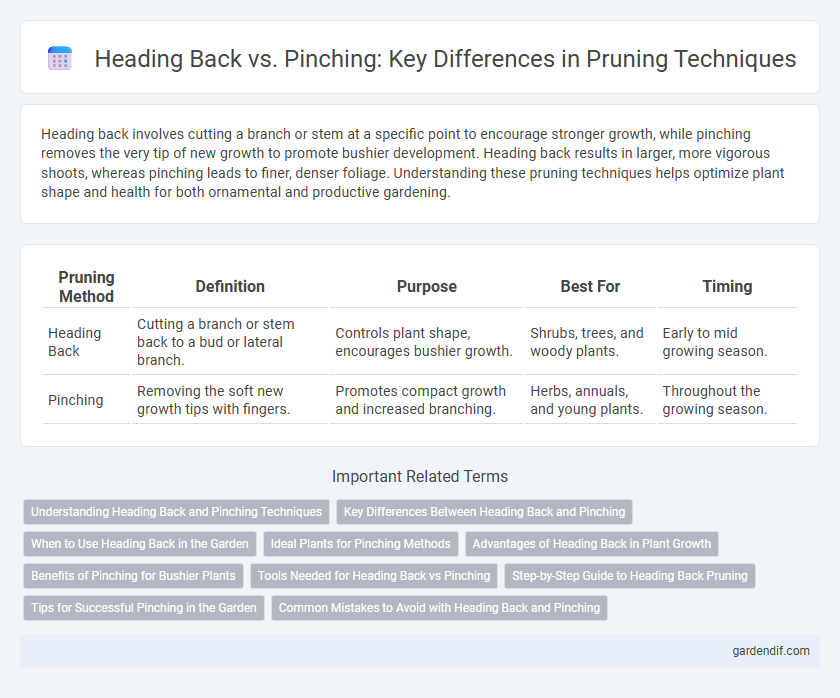
Heading back vs pinching Illustration
Heading back involves cutting a branch or stem at a specific point to encourage stronger growth, while pinching removes the very tip of new growth to promote bushier development. Heading back results in larger, more vigorous shoots, whereas pinching leads to finer, denser foliage. Understanding these pruning techniques helps optimize plant shape and health for both ornamental and productive gardening.
Table of Comparison
| Pruning Method | Definition | Purpose | Best For | Timing |
|---|---|---|---|---|
| Heading Back | Cutting a branch or stem back to a bud or lateral branch. | Controls plant shape, encourages bushier growth. | Shrubs, trees, and woody plants. | Early to mid growing season. |
| Pinching | Removing the soft new growth tips with fingers. | Promotes compact growth and increased branching. | Herbs, annuals, and young plants. | Throughout the growing season. |
Understanding Heading Back and Pinching Techniques
Heading back involves cutting the main stem or branch back to a strong lateral bud or branch to encourage robust growth and shape the plant, promoting a fuller structure. Pinching technique entails removing the soft tip of a new shoot by hand or with fingers, stimulating lateral branching and creating a bushier appearance. Both methods are essential in pruning strategies to control plant size and enhance flowering or fruit production.
Key Differences Between Heading Back and Pinching
Heading back involves cutting a branch or stem back to a main stem or bud, promoting bushier growth and stronger branches. Pinching removes only the tender tip of a shoot, encouraging lateral branching without drastically reducing the plant's size. The key difference lies in heading back's ability to shape plant structure versus pinching's role in enhancing density and compactness.
When to Use Heading Back in the Garden
Heading back is ideal for encouraging bushier growth and controlling the size of plants by cutting stems back to a lateral bud or branch. This technique is particularly useful in early spring to shape shrubs and promote new shoots before active growth begins. Use heading back when you need to rejuvenate overgrown plants or manage flowering by stimulating more branching.
Ideal Plants for Pinching Methods
Ideal plants for pinching methods include herbs like basil, mint, and rosemary, as well as flowering plants such as chrysanthemums and dahlias. Pinching encourages bushier growth by removing the soft, new tips of shoots, promoting lateral branching. Unlike heading back, which cuts back more mature stems, pinching is best suited for tender, fast-growing plants that respond well to light trimming.
Advantages of Heading Back in Plant Growth
Heading back stimulates vigorous lateral branching by cutting a main stem, resulting in a fuller, bushier plant structure ideal for improved light exposure and air circulation. This technique accelerates growth by redirecting energy from apical dominance to side shoots, enhancing overall plant density and productivity. Consequently, heading back supports robust development in flowering, fruiting plants, and ornamental shrubs, optimizing yield and aesthetic appeal.
Benefits of Pinching for Bushier Plants
Pinching promotes bushier plants by encouraging lateral growth through the removal of terminal buds, which redirects energy to side shoots. Unlike heading back, which cuts back larger sections, pinching is more precise and less stressful for the plant, resulting in denser foliage and improved light penetration. This technique enhances airflow and supports healthier, more vigorous plant development.
Tools Needed for Heading Back vs Pinching
Heading back requires sharp pruning shears or loppers to make clean, precise cuts on branches, which prevents damage and promotes healthy regrowth. Pinching involves using fingers or simple hand tools to remove soft, tender shoots without cutting tools, making it ideal for delicate plants and young stems. Proper tool selection ensures effective pruning techniques tailored to plant type and desired growth outcomes.
Step-by-Step Guide to Heading Back Pruning
Heading back pruning involves cutting a main shoot or branch back to a lateral bud to encourage bushier growth, while pinching removes only the soft tip of a stem to promote branching without significant size reduction. Begin heading back by identifying a healthy lateral bud or side shoot, then make a clean cut just above it at a 45-degree angle to stimulate new growth. Regularly inspect plants after pruning to remove any weak or diseased shoots and maintain an optimal shape and air circulation.
Tips for Successful Pinching in the Garden
Pinching is a precise pruning technique that involves removing the growing tips of plants to encourage bushier growth and increased flowering. Successful pinching requires timing when new shoots are soft and actively growing, typically in spring or early summer, to maximize the plant's energy distribution. Use clean, sharp fingernails or pruning shears to remove just the top 1/4 to 1/2 inch of the stem without damaging the main branches, promoting healthy lateral growth.
Common Mistakes to Avoid with Heading Back and Pinching
Heading back and pinching are popular pruning techniques often confused by gardeners, but common mistakes include cutting too far back with heading, which can stress plants and inhibit growth. Pinching errors often involve removing too much growth at once, reducing the plant's ability to photosynthesize effectively. Proper timing and understanding plant-specific needs are crucial to avoid damaging branches or stunting development.
Heading back vs pinching Infographic

 gardendif.com
gardendif.com